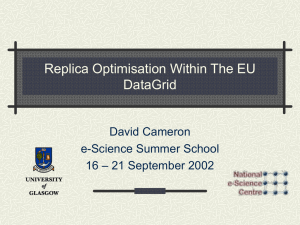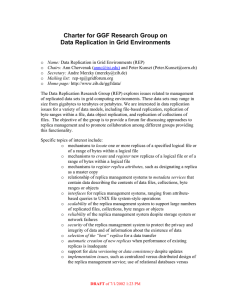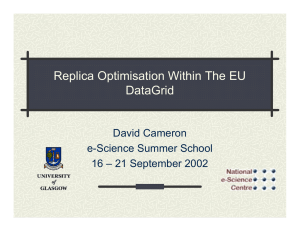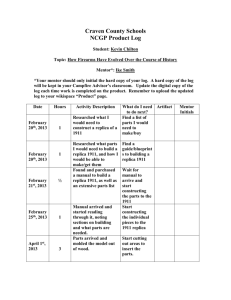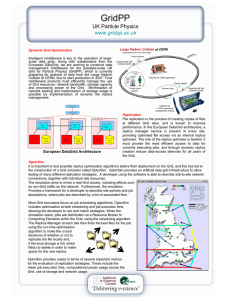EU DataGrid Data Management Services
advertisement
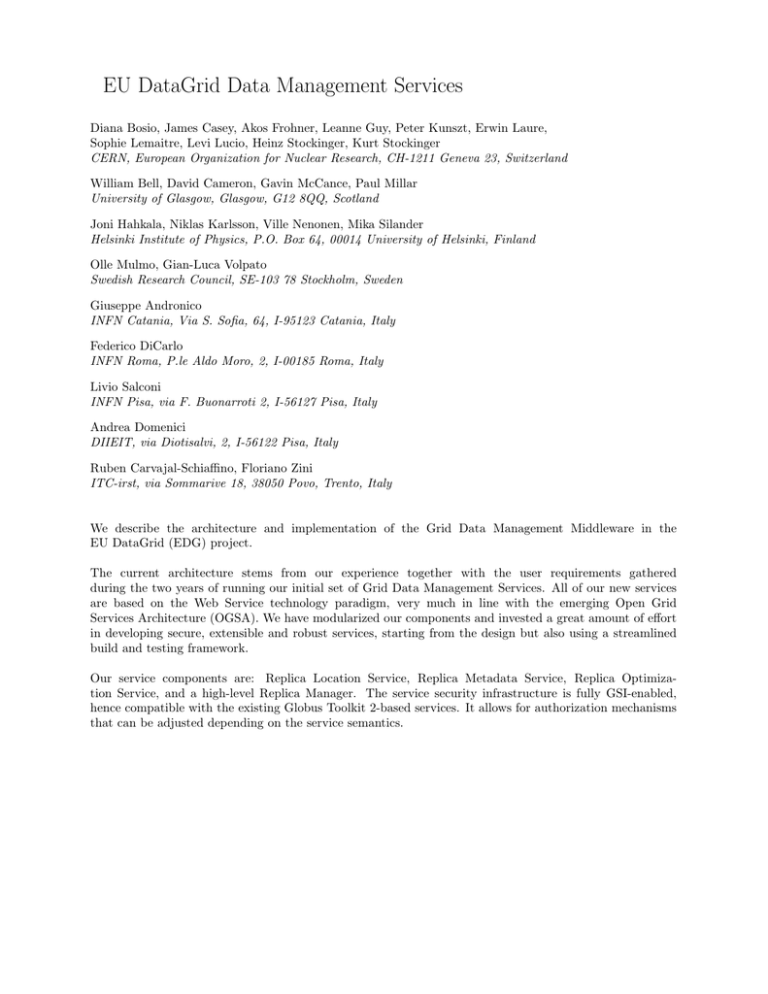
EU DataGrid Data Management Services Diana Bosio, James Casey, Akos Frohner, Leanne Guy, Peter Kunszt, Erwin Laure, Sophie Lemaitre, Levi Lucio, Heinz Stockinger, Kurt Stockinger CERN, European Organization for Nuclear Research, CH-1211 Geneva 23, Switzerland William Bell, David Cameron, Gavin McCance, Paul Millar University of Glasgow, Glasgow, G12 8QQ, Scotland Joni Hahkala, Niklas Karlsson, Ville Nenonen, Mika Silander Helsinki Institute of Physics, P.O. Box 64, 00014 University of Helsinki, Finland Olle Mulmo, Gian-Luca Volpato Swedish Research Council, SE-103 78 Stockholm, Sweden Giuseppe Andronico INFN Catania, Via S. Sofia, 64, I-95123 Catania, Italy Federico DiCarlo INFN Roma, P.le Aldo Moro, 2, I-00185 Roma, Italy Livio Salconi INFN Pisa, via F. Buonarroti 2, I-56127 Pisa, Italy Andrea Domenici DIIEIT, via Diotisalvi, 2, I-56122 Pisa, Italy Ruben Carvajal-Schiaffino, Floriano Zini ITC-irst, via Sommarive 18, 38050 Povo, Trento, Italy We describe the architecture and implementation of the Grid Data Management Middleware in the EU DataGrid (EDG) project. The current architecture stems from our experience together with the user requirements gathered during the two years of running our initial set of Grid Data Management Services. All of our new services are based on the Web Service technology paradigm, very much in line with the emerging Open Grid Services Architecture (OGSA). We have modularized our components and invested a great amount of effort in developing secure, extensible and robust services, starting from the design but also using a streamlined build and testing framework. Our service components are: Replica Location Service, Replica Metadata Service, Replica Optimization Service, and a high-level Replica Manager. The service security infrastructure is fully GSI-enabled, hence compatible with the existing Globus Toolkit 2-based services. It allows for authorization mechanisms that can be adjusted depending on the service semantics. 1 Introduction other services such as the Replica Location Service, Replica Optimization service etc. The EU DataGrid project [5] (EDG) is now in its final • Java Security Package: All of our services year. Within the data management work package we have very strict security requirements. The Java have developed a second generation of data managesecurity package provides tools that can be used ment services that will be deployed in EDG release in Grid services such as our replication services. 2.x. Our first generation replication tools (GDMP, edg-replica-manager etc.) provided a very good base These components are discussed in detail in the and input, which we reported on in [11, 12]. The following sections. experience we gained in the first generation of tools (mainly written in C++), is directly used in the second generation of data management services that are 2 Replication Service Framebased on web service technologies and mainly implework mented in Java. The basic design concepts in the second generation In the following section we first give an architectural services are as follows: overview of the entire replication framework and then discuss individual services in more detail. • Modularity: The design needs to be modular and allow for easy plug-ins and future extensions using agreed 2.1 standards. General Overview of Replication Architecture Figure 1 presents the user’s perspective of the main components of a Replica Management Service Since OGSA is an upcoming standard that is (RMS). This design, which first was discussed in [6], most likely to be adapted by several Grid serrepresents an evolution of the original design previces in the future, the design should allow for sented in [7, 8]. Several of the components have an easy adoption of the OGSA concept. It is also already been implemented and tested in EDG (see advisable to use a similar technology. shaded components) whereas others (in white) are Having implemented the first generation tools still in the design phase and might be implemented mainly in C++, the technology choices for the sec- in the future. RMS has been realized as a modular system that ond generation services presented in this article are provides easy plugability of third party components. as follows: RMS defines the minimal interface third party com• Java based servers are used that host web ser- ponents have to provide. According to this design vices (both upon Jakarta’s Tomcat and upon Or- the RMS acts as a logical single entry point to the system and interacts with the other components of acle 9iAS). the systems as follows: • Interface definitions in WSDL • The Core module provides the main functional• Client stubs for several programming languages ity of replica management, namely replica cre(Java, C/C++) through SOAP using AXIS for ation, deletion, and cataloging by interacting Java and gSOAP for C++ interfaces. with third party modules such as transport and replica and metadata catalog services. • Persistent service data is stored in a relational • Evolution: database management system. We mainly use MySQL for general services that require open source technology and Oracle for more robust services. The set of data management service described in this paper are: • Replication service framework: This service framework is the main part of our data management services and is described in detail in Section 2. It basically consists of an overall replica management system that uses several • The goal of the Optimization component (implemented as a service) is to minimize file access times by pointing access requests to appropriate replicas and pro-actively replicating frequently used files based on gathered access statistics. • The Security module manages the required user authentication and authorization, in particular, issues pertaining to whether a user is allowed to create, delete, read, and write a file. • Collections are defined as sets of logical filenames and other collections. User Processing Replica Management Service Security Core MetaData Catalog Replica Location Service Optimization Collection Sessions Consistency Transport Replica Selection AccessHistory Subscription ReplicaInitiation Figure 1: RMS’s main design components. • The Consistency module maintains consistency between all replicas of a given file, as well as between the meta information stored in the various catalogs. • The Session component provides generic checkpointing, restart, and rollback mechanisms to add fault tolerance to the system. We decided to implement the RMS and the core module functionality on the client side in the Replica Manager Client, henceforth referred to as the Replica Manager. The other subservices and APIs are modules and services in their own right, allowing for a multitude of deployment scenarios in a distributed environment. One advantage of such a design is that if a subservice is unavailable, the Replica Manager can still provide all the functionality that does not make use of that particular service. Also, critical service components may have more than one instance to provide a higher level of availability and to avoid service bottlenecks. A detailed description of the implemented components and services can be found in the following subsections as well as in the original design in [6]. 2.2 Interaction with Services The Replica Manager needs to interact with many external services as well as internal ones, such as the the Information Service and transport mechanisms like GridFTP servers [1]. Most of the components required by the Replica Manager are independent services, hence appropriate client stubs satisfying the interface need to be provided by the service. By means of configuration files the actual component to be used can be specified and Java dynamic class loading features are exploited for making them available at execution time. To date, the Replica Manager has been tested using the following components: • Replica Location Service (RLS) [3]: used for locating replicas in the Grid and assigning physical file names. • Replica Metadata Catalog (RMC): used for querying and assigning logical file names. • Replica Optimization Service (ROS): used for locating the best replica to access. • R-GMA: an information service provided by EDG: The Replica Manager uses R-GMA to obtain information about Storage and Computing Elements [6]. • Globus C based libraries as well as CoG [10] providing GridFTP transport functionality. • The EDG network monitoring services: EDG (in particular WP7) provides these services to obtain statistics and network characteristics. The implementation is mainly done using the Java J2EE framework and associated web service technologies (the Apache Tomcat servlet container, Jakarta Axis, Oracle 9iAS.). In more detail, we use client/server architectures making SOAP Remote Procedure Call (RPC) over HTTPS. The basic component interaction is given in Figure 2 and will also explained in a few more details in the following sub sections. For the user, the main entry point to the Replication Services is through the client interface that is provided via a Java API as well as a command line interface, the edg-replica-manager module. For each of the main components in Figure 1, the RMS framework provides the necessary interface. For instance, the functionality of the core module includes mainly the file copy and cataloging process and is handled in the client library with the respective calls to the Transport and Replica Catalog modules. 2.3 Replica Location Service (RLS) The Replica Location Service (RLS) is the service responsible for maintaining a (possibly distributed) catalog of files registered in the Grid infrastructure. For each file there may exist several replicas. This is due to the need for geographically distributed copies of the same file, so that accesses from different points of the globe may be optimized (see section on the Replica Optimization Service). Obviously, one needs to keep track of the scattered replicas, so that they can be located and consistently updated. As such, the RLS is designed to store one-tomany relationships between (Grid Unique Identifiers (GUIDs) and Physical File Names (PFNS). Since many replicas of the same file may coexist (with different PFNs) we identify them as being replicas of the same file by assigning to them the same unique identifier (the GUID). The RLS architecture encompasses two logical components - the LRC (Local Replica Catalog) and the RLI (Replica Location Index). The LRC stores the mappings between GUIDs and PFNs on a per-site basis whereas the RLI stores information on where mappings exist for a given GUID. In this way, it is possible to split the search for replicas of a given file in two steps: in the first one the RLI is consulted in order to determine which LRCs contain mappings for a given GUID; in the second one, the specific LRCs are consulted in order to find the PFNs one is interested in. It is however worth mentioning that the LRC is implemented to work in standalone mode, meaning that it can act as a full RLS on its own if such a deployment architecture is necessary. When working in conjunction with one (or several) RLIs, the LRC provides periodic updates of the GUIDs it holds mappings for. These updates consist of bloom filter ob- jects, which are a very compact form of representing a set, in order to support membership queries [13]. 2.4 Replica Metadata Catalog Service (RMC) Despite the fact that the RLS already provides the necessary functionality for application clients, the GUID unique identifiers are difficult to read and remember. The Replica Metadata Catalog (RMC) can be considered as another layer of indirection on top of the RLS that provides mappings between Logical File Names (LFNs) and GUIDs. The LFNs are user defined aliases for GUIDs - many LFNs may exist for one GUID. Furthermore, the RMC is also capable of holding metadata about the original physical file represented by the GUID (e.g. size, date of creation, owner). It is also possible for the user to define specific metadata and attach it to a GUID or to an LFN. The purpose of this mechanism is to provide to users and applications a way of querying the file catalog based on a wide range of attributes. The possibility of gathering LFNs as collections and manipulating these collections as a whole has already been envisaged, but is not yet implemented. 2.5 Replica (ROS) Optimization Service The goal of the optimization service is to select the best replica with respect to network and storage access latencies. It is implemented as a light-weight web service that gathers information from the EDG network monitoring service and the EDG storage element service about the respective data access latencies. In [2] we defined the APIs getNetworkCosts and getSECosts for interactions of the Replica Manager with the Network Monitoring and the Storage Element Monitor. These two components monitor the network traffic and the access traffic to the storage device respectively and calculate the expected transfer time of a given file with a specific size. In the EU DataGrid Project, Grid resources are managed by the meta scheduler of WP1, the Resource Broker [4]. One of the goals of the Resource Broker is to decide on which Computing Element the jobs should be run such that the throughput of all jobs is maximized. Assuming highly data intensive jobs, a typical optimization strategy could be to select the least loaded resource with the maximum amount of locally avaliable data. In [2] we introduced the Replica Manager API getAccessCost that returns the access costs of a specific job for each candidate Resource Broker Information Service User Interface Replica Manager Client Replica Location Service Replica Optimization Storage Element Monitor Storage Element Network Monitor Figure 2: Interaction of Replica Manager with other Grid components. Computing Element. The Resource Broker can then take this information provided by the Replica Manager to schedule each job to its optimal resources. The interaction of the Replica Manager with the Resource Broker, the Network Monitor and the Storage Element Monitor is depicted in Figure 2. 3 Security The EDG Java security package covers two main security areas, authentication authorization. Authentication assures that the entity (user, service or server) at the other end of the connection is who it claims to be. Authorization decides what the entity is allowed to do. The aim in the security package is always to make the software as flexible as possible and to take into account the needs of both EDG and industry to make the software usable everywhere. To this end there has been some research into similarities and possibilities for cooperation with for example Liberty Alliance, which is a consortium developing standards and solutions for federated identity for web based authentication, authorization and payment. 3.1 Authentication The authentication mechanism is an extension of the normal Java SSL authentication mechanism. The mutual authentication in SSL happens by exchanging public certificates that are signed by trusted certificate authorities (CA). The user and the server prove that they are the owners of the certificate by proving in cryptographic means that they have the private key that matches with the certificate. In Grids the authentication is done using GSI proxy certificates that are derived from the user certificate. This proxy certificate comes close to fulfilling the PKIX [9] requirement for valid certificate chain, but does not fully follow the standard. This causes the SSL handshake to fail in the conforming mechanisms. For the GSI proxy authentication to work the SSL implementation has to be nonstandard or needs to be changed to accept them. The EDG Java security package extends the Java SSL package. It • accepts the GSI proxies as the authentication method • supports GSI proxy loading with periodical reloading • supports OpenSSL certificate-private key pair loading • supports CRLs with periodical reloading • integrates with Tomcat • integrates with Jakarta Axis SOAP framework The GSI proxy support is done by finding the user certificate and making special allowances and restrictions to the following proxy certificates. The allowance is that the proxy certificate does not have to be signed by a CA. The restriction is that the distinguished name (DN) of the proxy certificate has to start with the DN of the user certificate (e.g. ‘C=CH, O=cern, CN=John Doe’). This way the user cannot pretend to be someone else by making a proxy with DN ‘C=CH, O=cern, CN=Jane Doe’. The proxies are short lived, so the program using the SSL connection may be running while the proxy is updated. For this reason the user credentials (for example the proxy certificate) can be made to be reloaded periodically. OpenSSL saves the user credentials using two files, one for the user certificate and the other for the private key. With the EDG Java security package these credentials can be loaded easily. The CAs periodically release lists of revoked certificates in a certificate revocation list (CRL). The EDG Java security package supports this CRL mechanism and even if the program using the package is running, these lists can be periodically and automatically reloaded into the program by setting the reload interval. The integration to Jakarta Tomcat (a Java web server and servlet container) is done with an interface class and to use it only the Jakarta Tomcat configuration file has to be set up accordingly. The Jakarta Axis SOAP framework provides an easy way to change the underlying SSL socket implementation on the client side. Only a simple interface class was needed and to turn it on a system variable has to be set while calling the Java program. In the server side the integration was even simpler as Axis runs on top of Tomcat and Tomcat can be set up as above. Due to issues of performance, many of the services described in this document have equivalent clients written in C++. To this end, there are several C++ SOAP clients that have been written based on the gSOAP library. In order to provide the same authentication and authorization functionality as in the corresponding Java SOAP clients, an accompanying C library is being developed for gSOAP. When ready, it is to provide support for mutual authentication between SOAP clients and SOAP servers, support for the coarse-grained authorization as implemented in the server end by the Authorization Manager (described below) and verification of both standard X509 and GSI style server and server proxy certificates. inside the service, because the actual file to access is only known during the execution of the service. The authorization mechanism is positioned in the server before the service. In the EDG Java security package the authorization is implemented as role based authorization. Currently the authorization is done in the server end and the server authorizes the user, but there are plans to do mutual authorization where also the client end checks that the server end is authorized to perform the service or to save the data. The mutual authorization is especially important in the medical field where the medical data can only be stored in trusted servers. The role based authorization happens in two stages, first the system checks that the user can play the role he requested (or if there is a default role defined for him). The role the user is authorized to play is then mapped to a service specific attribute. The role definitions can be the same in all the services in the (virtual) organization, but the mapping from the role to the attribute is service specific. The service specific attribute can be for example a user id for file system access of database connection id with preconfigured access rights. If either step fails, the user is not authorized to access the service using the role he requested. There are two modules to interface to the information flow between the client and the service; one for normal HTTP web traffic and the other for SOAP web services. The authorization mechanism can attach to other information flows by writing a simple interface module for them. In a similar fashion the authorization information that is used to make the authorization decisions can be stored in several ways. For simple and small installation and for testing purposes the information can be a simple XML file. For larger installations the information can be stored into a database and when using the Globus tools to distribute the authorization information, the data is stored in a text file that is 3.2 Coarse grained authorization called the gridmap file. For each of these stores there The EDG Java security package only implements the is a module to handle the specifics of that store and to coarse grained authorization. The coarse grained au- add a new way to store the authorization information. thorization decision is made in the server before the Only a interface module needs to be written. When actual call to the service and can make decisions such the virtual organization membership service (VOMS) as ‘what kind of access does this user have to that is used the information provided by the VOMS server database table’ or ‘what kind of access does this user can be used for the authorization decisions and all the have to the file system’. The fine grained authoriza- information from the VOMS is parsed and forwarded tion that answers the question ‘what kind of access to the service. An authorization management web does this user have to this file’ can only be handled interface is also provided. 4 Conclusions [5] European DataGrid project http://www.eu-datagrid.org (EDG): The second generation of our data management services has been designed and implemented based on [6] L. Guy, P. Kunszt, E. Laure, H. Stockinger, K. Stockinger “Replica Management in Data Grids”, the web service paradigm. In this way, we have a Technical Report, GGF5 Working Draft, Edinflexible and extensible service framework and are thus burgh Scotland, July 2002 prepared to follow the general trend of the upcoming OGSA standard that is based on web service technol- [7] Wolfgang Hoschek, Javier Jaen- Martinez, Peogy. ter Kunszt, Ben Segal, Heinz Stockinger, Kurt Our deployment choices have been as follows: we Stockinger, Brian Tierney, ”Data Management aim to support robust, highly available commercial (WP2) Architecture Report”, EDG Deliverable products (like Oracle/DB and Oracle/Application 2.2, http://edms.cern.ch/document/332390 Server) as well as standard open source technology [8] Wolfgang Hoschek, Javier Jean-Martinez, Asad (MySQL, Tomcat, etc.). Samar, Heinz Stockinger, Kurt Stockinger. Data The first experience in using the new generation of Management in an International Data Grid services shows that basic performance expectations Project. 1st IEEE/ACM International Workshop are met. The services are currently being deployed on Grid Computing (Grid’2000). Bangalore, Inupon the EDG testbed. dia, Dec 17-20, 2000. [9] R. Housley et.al. “Internet X.509 Public Key Infrastructure Internet X.509 Public Key Infrastructure, RFC 3280, The Internet Society April This work was partially funded by the European 2002, http://www.ietf.org/rfc/rfc3280.txt Commission program IST-2000-25182 through the EU DataGrid Project. [10] Gregor von Laszewski, Ian Foster, Jarek Gawor, Peter Lane: “A Java Commodity Grid Kit”, Concurrency and Computation: Practice and ExperiReferences ence, 13(8-9), 2001. 5 Acknowledgments [1] W. Allcock, J. Bester, J. Bresnahan, A. [11] H. Stockinger, A. Samar, B. Allcock, I. Foster, K. Holtman, B. Tierney. ”File and Object RepliChernevak, I. Foster, C. Kesselman, S. Meder, V. cation in Data Grids.” Proceedings of the Tenth Nefedova, D. Quesnal, S. Tuecke; ”Data ManageInternational Symposium on High Performance ment and Transfer in High Performance CompuDistributed Computing (HPDC-10), IEEE Press, tational Grid Environments.” Parallel ComputAugust 2001 ing, 2002. [2] W. H. Bell, D. G. Cameron, L. Capozza, [12] Heinz Stockinger, Flavia Donno, Erwin Laure, Shahzad Muzaffar, Giuseppe Andronico, Peter P. Millar, K. Stockinger, F. Zini, Design of Kunszt, Paul Millar. “Grid Data Management in a Replica Optimisation Framework, TechniAction: Experience in Running and Supporting cal Report, DataGrid-02-TED-021215, Geneva, Data Management Services in the EU DataGrid Switzerland, December 2002. Project”, Computing in High Energy Physics (CHEP 2003), La Jolla, California, March 24 [3] Ann Chervenak, Ewa Deelman, Ian Fos28, 2003. ter, Leanne Guy, Wolfgang Hoschek, Adriana Iamnitchi, Carl Kesselman, Peter Kunszt, Matei [13] B. Bloom “Space/time tradeoffs in hash codRipenu, Bob Schwartzkopf, Heinz Stocking, Kurt ing with allowable errors”, CACM, 13(7):422-426, Stockinger, Brian Tierney , “Giggle: A Frame1970. work for Constructing Scalable Replica Location Services”,Proceedings of SC2002 Conference, November 2002 [4] DataGrid WP1, Definition of Architecture, Technical Plan and Evaluation Criteria for Scheduling, Resource Management, Security and Job Description, Technical Report, EU DataGrid Project. Deliverable D1.2, September 2001.


